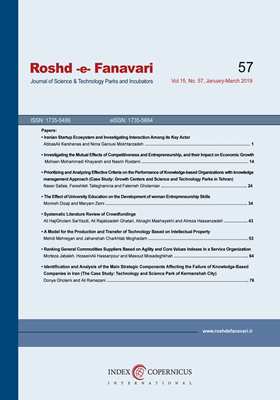-
-
List of Articles
-
Open Access Article
1 - Ranking General Commodities Suppliers Based on Agility and Core Values Indexes In a Service Organization
morteza jabale Hossein Ali Hassan pour Masoud Mosaddegh khah -
Open Access Article
2 - A Model for the Production and Transfer of Technology Based on Intellectual Property
Mehdi Meregan Jahanshah Charkhtab-moghadam -
Open Access Article
3 - Identification and Analysis of the Main Strategic Components Affecting the Failure of Knowledge-Based Companies in Iran (The Case Study: Technology and Science Park of Kermanshah City)
Donya Gholami Ali Ramezani -
Open Access Article
4 - Iranian Startup Ecosystem and Investigating Interaction Among its Key Actor
Abbasali Karshenas nima Garoosi Mokhtarzadeh -
Open Access Article
5 - Systematic Literature Review of Crowdfunding
Ali Haji Gholam Saryazdi Ali Rajabzadeh Ghatari Alinaghi Mashayekhi Alireza hassanzadeh -
Open Access Article
6 - Prioritizing and Analyzing Effective Criteria on the Performance of Knowledge-based Organizations with knowledge management Approach (Case Study: Growth Centers and Science and Technology Parks in Tehran)
naser safaei Fatemeh Gholamian fereshte thaleghani -
Open Access Article
7 - The Effect of University Education on the Development of woman Entrepreneurship Skills
Monireh Dizaji Maryam zeini -
Open Access Article
8 - The Study of the Relationship between Entrepreneurship, Competitiveness and Economic Growth
Mohsen Mohammadi Khyareh Nasrin Rostami
-
The rights to this website are owned by the Raimag Press Management System.
Copyright © 2017-2026







